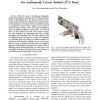Free Online Productivity Tools
i2Speak
i2Symbol
i2OCR
iTex2Img
iWeb2Print
iWeb2Shot
i2Type
iPdf2Split
iPdf2Merge
i2Bopomofo
i2Arabic
i2Style
i2Image
i2PDF
iLatex2Rtf
Sci2ools
ICRA
2008
IEEE
2008
IEEE
Biological stiffness control strategies for the Anatomically Correct Testbed (ACT) hand
— With the goal of developing biologically inspired manipulation strategies for an anthropomorphic hand, we investigated how the human central nervous system utilizes the hands redundant neuromusculoskeletal biomechanics to transition between conditions. Using a experiment protocol where subjects were asked to transit between control states with equal end-effector force but different stiffness requirements, we observed that (1) some subjects used the same muscle synergy for both conditions by maintaining the same synergy throughout the transition, and (2) other subjects used two different muscle synergies to execute two conditions by transiting from one synergy to another rapidly. We hypothesize that humans typically try to use the same muscle synergy to execute two tasks when it is possible to optimize on the simplicity and speed over energy. This is a different control strategy from the way robots have been controlled in the past, and it provides a new direction in controlling an a...
| Added | 30 May 2010 |
| Updated | 30 May 2010 |
| Type | Conference |
| Year | 2008 |
| Where | ICRA |
| Authors | Ravi Balasubramanian, Yoky Matsuoka |
Comments (0)

